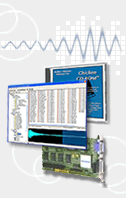 Slice Formats in Chicken Systems Products Slice Formats in Chicken Systems Products
May 14th, 2015 - Translator™ (and our other products) have excellent support for "Slice Formats" which are Recycle, ACID, AppleLoops, Stylus RMX, and a couple more.
Slice Theory
Slice formats work off the principle of separated slices playing back at any tempo. This is done by taking a rhythmic loop, which can be melodic or percussive, and placing makers at strategic points where a "slice" begins. A "slice" usually represents a musical note or a percussive strike.
Slice Files and Slice Engines
A "slice format" always depends on a "slice engine" to play it back. A slice engine reads those markers and plays back the slices IN TIME with an adjustable tempo parameter. Of course, if the tempo is the same, the slices are played back one after the other, with each slice coming in exactly where the last one left off. For faster tempos, the slices are played back at a faster rate, with the previously-played slice cutting off or fading out as the new slice comes in. For slower tempos, OFTEN (not all the time) the slice engine synthesizes sample material to fill in the gap between slices.
Where You Find Slice Engines
Often slice engines are in DAW's like Logic or ProTools. Any DAW worth anything will take a slice file and understand that it's a slice file and it'll play it back according to the tempo it's playing at that particular time. For example, Garage Band shows regular WAVE files as a green rectangle, whereas a slice file will show as a blue rectangle. That way you know it's tempo-dependent or not.
Are Samplers Slice Engines?
Usually not. Only Kontakt and EmulatorX AFAIK have that capacity. But it's easy to simulate a Slice Engine on any sampler, using Translator. Here's the steps.
Use Translator to convert your Slice File(s) to your samplers format
You'll wind up, by default, with as many samples as slices, plus the entire loop on the lowest key, The settings for this are under Format Preferences-Recycle (see below). You can select As Individual Slices, or both. You need the slices. You can also set what keyrange you choose. And select Write MIDI File as well, this is important.

Load Your New Program Into Your Sampler
You'll find the slices playable in the keyrange you selected. Of course they don't play in the rhythm they originally did (this is where converting the whole loop also is helpful as a guide), but you can come up with your own stuff, if you want. But we're after doing the SAME rhythm, or at least close to it.
Start Your DAW and load the MIDI file Translator created
The MIDI file is set to play the same notes that Translator converted, at the same relative rhythm the Slice File programmed. So simply play the notes with that MIDI pattern created by the MIDI file in your DAW. INSTANT SLICE FILE PLAYBACK!
Now obviously the one drawback is that on faster tempos, a previous slice doesn't cut off like it would on a slice player. But you do have the option, depending on the flexibility of your sample player, to use the envelopes to cut them off at whatever tempo you choose. Another idea is set up a modulator to decrease the DECAY segment in the envelope so you can vary the cutoff. (Perhaps we'll put this in as a feature to Translator in a later version.
Remember with Translator you can do this on ANY slice file format: Recycle, ACID, AppleLoop, Stylus RMX.
Just Change The Tempo
Another perhaps simpler thing you can do is export the sample at a different tempo. Look up at the Preferences dialog graphic above; the Slice File Tempo Change parameter makes when you export out an entire loop, it will be that particular tempo, not just the one that it's hardcoded to. So if you already know what tempo you want, for example a Recycle file -> SFZ file at the tempo 96bpm, you can set Translator to that tempo and the resulting SFZ file will have an exported WAVE file that reflects that particular tempo. Cool! And again, this works with ANY Slice File.
Extensive use of Slice Formats is exclusive to Translator and Chicken Systems products. There's many other things you can do with Translator and Slice Formats, just get in and explore!
|



